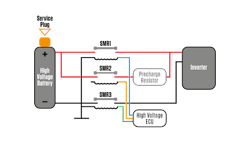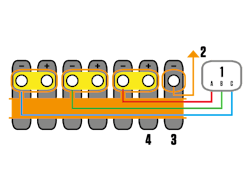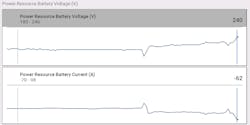Toyota Prius high voltage system fault
Snap-On-Diagnostics has released a technical reference for a Toyota Prius high voltage system fault. This Toyota Prius had malfunction warning lights illuminated and two faults relating to the high voltage system stored.
| Module | Code |
| Hybrid Control Module | P3000 Battery Control System |
| HV Battery Control Module | P0AFA Hybrid Battery System Voltage Low |
Intermittently, the vehicle would not enter “ready mode” and the high voltage system would remain inactive as the high voltage contactors (system main relay SMR 1, 2 ,and 3) were not being switched on by the high voltage control module.
The system has three SMRs:
- SMR 1: Positive Contactor
- SMR 2: Pre-charge Contactor
- SMR 3: Negative Contactor
Sequence of operation of SMRs:
| Ready On | |||
| SMR 1 | SMR 2 | SRM 3 | |
| Stage 1 | Off | Off | Off |
| Stage 2 | Off | On | On |
| Stage 3 | On | On | On |
| Stage 4 | On | Off | On |
| High Voltage System Off | |||
| SMR 1 | SMR 2 | SRM 3 | |
| Stage 1 | On | Off | On |
| Stage 2 | Off | Off | On |
| Stage 3 | Off | Off | Off |
As the high voltage battery is located in the luggage compartment and access is difficult, live data was used to monitor the battery voltage for each battery block. The high voltage battery is made up of 14 x 14.4V blocks. Each block is made up of 2 x 7.2V cells. This equates to a total voltage of 201.6V. Anything over 60V direct current (DC) is considered high voltage, so precautions must be taken when working on such a vehicle, including appropriate training, PPE, insulated tooling, etc.
A high voltage system must only be worked on by suitably qualified technicians. The high voltage service plug must be removed and the system allowed adequate time to de-energize prior to carrying out work on the system.
Each battery block has a sensing wire attached to a negative stud, which is wired to the high voltage control module.
The diagram below shows three blocks as an example:
The first two graphs can be seen to be erratic and not behaving like the other two. The voltage had an irregular cycle between 16V negative and 15V positive. This condition isn’t possible, so further investigation was required, which required disassembly of the battery casing.
The bus bars connecting the battery cells were found to be corroded so were removed and cleaned. The wiring and connections associated with the battery block sensing circuits were also inspected and cleaned.
Once the system was reassembled and powered up, the fault was found to still be present. Next, the connections on the high voltage battery control module were inspected, and it was found that three of the pins on the module were badly corroded.
This module was replaced and the fault codes cleared. The live data now displayed the correct voltage of each battery block.
The image above shows the voltage for four battery blocks under hard acceleration, resulting in a noticeable voltage drop on each block. All 14 blocks should return a similar voltage under all conditions, including full-electric mode, hard acceleration and regenerative braking.
The image above shows the voltage for four battery blocks under regenerative braking, resulting in voltage increase on each block.
The Prius information display shows the driver the current driving mode through the energy monitor, which is helpful for fault finding. States are as described:
- Vehicle Stationary with engine off
- Normal Driving – ICE operating
- Vehicle operating in full electric mode
- High Voltage Battery being charged through regenerative braking
Monitoring High Voltage Battery Condition
While road testing the vehicle, check the condition of the high voltage battery under certain operating conditions.
Regenerative Braking
EV Mode
During this test we are looking for a difference of no greater than 0.3 volts between any of the battery blocks under load.
The image below shows the relationship between current and voltage under both conditions.
After road testing the vehicle and carrying out a post scan with the diagnostic tool, the vehicle was returned to the customer.













